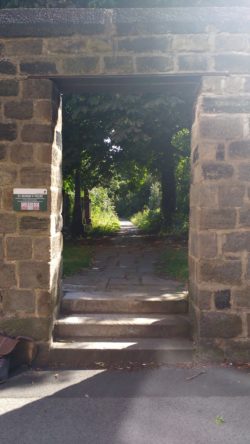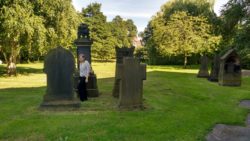The Dead and the Living Interconnected on Campus

An Introduction to St George’s Field
By Imogen Gerard and Kelsie Root
Cemeteries play an integral role in remembering the dead. They are a space shared by the living and the dead, enabling these two groups to interact and have a relationship.
St George’s Field, previously the Leeds General Cemetery, is a fascinating example of a space where the dead and the living coexist. Between 1835 and 1969, over 97,000 people were interred at this cemetery. Today the area is open to the public as a green space on the University of Leeds campus. The former cemetery is a quiet spot where people enjoy their breaks, as well as being a habitat to an array of wildlife. Everyday hubbub and life buzzes amongst reminders of those lying at rest: clusters of gravestones and the chapel.
 Leeds General Cemetery also comes alive in the detailed records of those buried there, held by Special Collections in the Brotherton Library. These burial registers have been digitised as part of the Medical Collections project, and are available for browsing and searching online here.
Leeds General Cemetery also comes alive in the detailed records of those buried there, held by Special Collections in the Brotherton Library. These burial registers have been digitised as part of the Medical Collections project, and are available for browsing and searching online here.
As an offshoot of the Living with Dying project a couple of student interns - Imogen and Kelsie, who you can find out more about here - are spending the summer doing research and creating resources to enrich the Leeds General Cemetery Collection and its digitised registers. At the heart of this project is the cemetery which exists today as St George’s Field. For this reason, this blog post provides an introduction to St George’s Field, its history and its role today.
The Leeds General Cemetery company was founded in 1833 with the aim of establishing a public cemetery in Leeds that was open to all denominations and faiths. The site of St George’s Field, opposite Woodhouse Moor and Hyde Park, was acquired for this purpose. To determine the cemetery's style and features, a public competition was announced. The winning design was submitted by architect John Clark. The committee were keen to make the cemetery a pleasant place and Clark’s design was chosen for its attractiveness as well as it functionality. The cemetery was built over the course of 1834-5, and opened later that year. The first burial was in July 1835.
Over the next 134 years, the dead were buried and ashes were scattered at Leeds General Cemetery. People of all faiths and backgrounds were laid to rest at this site. Over 100 casualties from the First and Second World Wars were interred there. The cemetery was also associated with the Leeds Maternity Hospital, which meant that many infants and babies were buried there.
Later the cemetery fell into disuse. By the 1930s it was running low on space for further burials and in the 1940s the site became overgrown and neglected. By this point University of Leeds buildings surrounded the cemetery. In 1956 the University decided to acquire the Leeds General Cemetery company and convert it into a private limited company. Fewer and fewer people visited the cemetery during this time.
In 1965, a Parliamentary Act was passed giving the University the power and permission to discontinue interments and create a public open space. Work transforming the cemetery was carried out in 1968. The majority of headstones and memorials were removed and then the land was grassed over and landscaped. In 1969 the site was reopened to the public under its original name of St George’s Field.

Today St George’s Field has a unique function. It is a valued green space on campus, whose history as a cemetery remains apparent. Because it is spacious and not particularly well known, it is consistently a quiet spot. The presence of the chapel and the remaining gravestones contribute to this area’s meditative quality. In summer, students and those passing through will inevitably be found lounging on the grassy banks and numerous benches. Recently the site has become valued for its biodiversity; it provides habitats for bees, birds and bats. Around St George’s Field grow many naturally occurring berry plants which are free to be picked and enjoyed by the public.
St George’s Field is nestled behind the Henry Price Halls of Residence, with the School of Design bordering one side and the School of Mechanical Engineering on the other. Despite spanning a significant proportion of campus grounds, this appealing spot can seem fairly hidden. Many students, staff and Leeds locals are surprised to hear of its existence. St George’s Field acts as a memoriam to the old cemetery, yet its own existence isn’t always readily remembered. This may change as the University is considering undertaking a project to enhance and protect the site. To find out more or contribute your own view, visit the 'University of Leeds Sustainability' page on the St George's Field project, here.
This is the first in a series of blogs resulting from Imogen and Kelsie’s research into the Leeds General Cemetery Burial Registers. To learn more about the cemetery, its archival collection and this project, watch this space.
